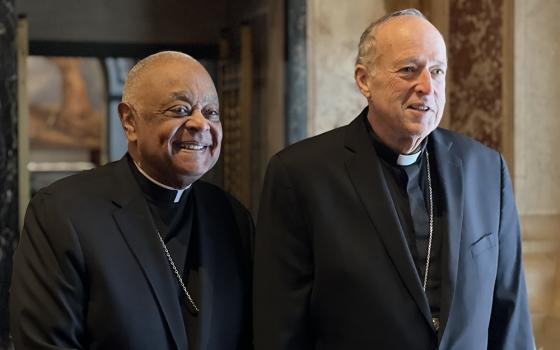At the extraordinary Synod of Bishops on the family meeting in Rome through Oct. 19, divorce, remarriage and annulments have been widely -- by some accounts, passionately -- discussed.
At a press briefing Thursday, Cardinal Francesco Coccopalmerio, the head of the Pontifical Council for Legislative Texts and a member of the new papal commission appointed to study reforms to the church's processes and laws governing the sacrament of marriage, said that a simplification of the annulment process is among the topics of study.
The Instrumentum Laboris for the synod poses the question of the canonical irregularity of divorced and remarried Catholics as one topic for discussion. The church's constant interpretation of Canon 915 has been that civilly divorced and remarried Catholics cannot receive the Eucharist at Mass because they are living in a state of grave sin, that sin being the adultery that they commit with their second spouse every time that they make love -- in the church's interpretation of Christ's injunction in Mark 10:11, such relations are adulterous.
The instrumentum discusses some possible approaches to this issue, and Coccopalmerio said Thursday that these approaches are also part of his commission study. One is the way of our Orthodox brothers and sisters, who allow a second, nonsacramental marriage after a divorce with continued participation in the Eucharist. This approach has come to be identified with Cardinal Walter Kasper, and it has attracted serious criticism from other cardinals.
But another approach outlined in the instrumentum is gaining steam and may be more likely to be adopted over Kasper's approach because it is much less controversial. This approach is a streamlining of the canonical process for marriage cases. Pope Francis has already moved on this proposal by creating a commission to study a reform of the church's laws in this area. And Cardinal Péter Erdő, the relator for the synod, spoke in his introductory remarks to the synod of the necessity of "an effective and streamlined process in the ... invalidity of the [marriage] bond."
Today, as a result of the 1983 Code of Canon Law, the juridical process by which the church declares a marriage invalid is rather complex. It requires the participation of six judges and two defenders of the bond at two different levels, first and second instance -- namely, the trial and appeal levels -- before invalidity can be determined. It does not have to be so complicated, and, in fact, it has not always been so complicated. In solving what appear to be current problems, it makes sense to see how we have handled these issues in the past and not fall into the categorical error that the way things presently are in the church excludes any other alternative, that things have always been as they are presently. In terms of the church's canonical process for declaring the invalidity of a marriage, it has definitely not always been as it is now.
Prior to the adoption of the 1917 Code of Canon Law, a piece of legislation that centralized more power in the diocesan chanceries and the papal curia than they had ever historically had, the most frequently used juridical process for determining the invalidity of a marriage in the church was something called the "summary process." This process had its origin in the church of the early 14th century and was used, rather consistently and finally almost exclusively, to handle marriage invalidity cases until the 1917 code changed things. That's a 600-year run.
In 1306, with the decree Saepe Contingit, Pope Clement V established that church courts, in one-judge panels, could hear cases "sine strepitu judicii et figura," a Latin phrase that meant without all the formal steps of a normal juridical process. According to Saepe Contingit, a judge could omit a formal libellus (complaint) in a case, could omit a formal statement of issues, could limit the number of witnesses, could rule quickly on objections, could narrow the issues presented by the parties, and could disallow unnecessary appeals. What a judge could not do was omit necessary proofs and legitimate defenses. In 1311, Clement in his decree Dispendiosam made it clear that this summary process was to be used in marriage cases. The famous canonist of the 19th century, Jesuit Fr. Franz X. Wernz, explained the summary process as "a trial in which the solemnities required by the natural law are observed while those formalities which retard the expeditious pace of the proceedings, and which are required only by human law are omitted."
The summary process was used for marriage invalidity cases until 1917, when the first Code of Canon Law became effective, substituting a much more rigid juridic process for these cases, involving three-judge panels and mandatory appeals before yet another three-judge panel. The 1917 code put an end to the summary process, but it was not dead. In 1969, motivated by the events of the Second Vatican Council and based on proposals by the Canon Law Society of America, the National Conference of Catholic Bishops asked the Apostolic See to approve, on an experimental basis, the American Procedural Norms (APNs) for marriage cases.
The APNs reached back into church history and based themselves on the ancient summary process. The APNs went from being a three-year experiment to being the law for marriage cases in the United States until the 1983 code. Under the APNs, one judge could hear a marriage case in most circumstances, there was no mandatory appeal to a second instance tribunal, and very short time frames were established for each part of the entire invalidity process so that a case could move from start to finish in eight months. It was a good system, a fair system, maintaining the necessities of a juridical process without any retarding formalities. Under the APNs, tens of thousands of American Catholics had their marriage invalidity issues dealt with by the church's streamlined judicial process.
Alas, the 1983 Code of Canon Law, much as its predecessor in 1917, undid these changes, and more or less returned to the heavily formalistic juridical process for the determination of marriage invalidity favored by the 1917 code. At the press conference Thursday, Coccopalmerio suggested that we could get by with one judge per marriage invalidity process and no mandatory appeal. That's basically what the APNs did.
It's time to dig the American Procedural Norms out of the drawer and consider them as a basis for changing the church's universal law on marriage invalidity processes.
[Nicholas P. Cafardi is a civil and canon lawyer and a professor and former dean at Duquesne University School of Law in Pittsburgh.]


